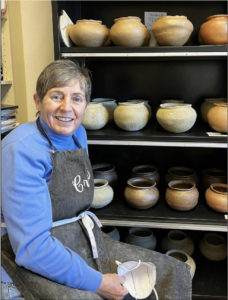Form & Function
Volunteers Helping Archaeologists Understand Pottery

One of the fun challenges of archaeology is understanding form and function from the features and artifacts left behind that have managed to survive to excavation. This is especially true for pottery, where form (aka the shape and size) and technological design do not always have modern analogs for understanding their function. Understanding the varied forms and technologies of past pottery often falls into the realm of experimental archaeology. The experiments aim to fill in the gaps of our knowledge of the archaeological and cultural record through reconstruction and testing different functional models. It often requires a lot of time, energy, and resources, and as such isn't regularly a part of enterprise archaeology. But it has become a part of the Office of Archaeological Studies repertoire of projects through the dedicated work of two volunteers.
Cristi Branum and Lydia Sanford, have been steadfast volunteers in the pottery laboratory, using the principles of experimental archaeology to understand the form, technological design, and function of two types of unique pottery – Micaceous wares and Chaco cylinder jars. Starting in 2016, these two potters honed their micaceous clay skills and created dozens of micaceous clay pots of various compositions. While the form of all the pots produced are the same, the quantities and types of clay, temper, and mica varied. The idea is to see how these varied composition pots respond to different stressors and understand why mica became such a prevalent inclusion in the pottery from the northern Rio Grande. The dozens of pots have been drying for far longer than any past piece of pottery would have experienced, thanks to delays from the COVID-19 pandemic that have prevented the firing of these beautiful works of art outside in a fire, rather than an electric kiln.
In the meantime, these wonderful volunteers are now assisting Dr. Patricia Crown (UNM) in a partnership with OAS to create Chaco style cylinder jars. This form of pottery is found almost exclusively in Chaco Canyon and especially at Pueblo Bonito. Their unique shapes and scarcity have prompted numerous studies, including Dr. Crown's discovery of theobromine, a residue of chocolate, within some jars. Chocolate played an important social role in ancient Mexico, which implies that these cylinders may have served a similar role in Chaco Canyon ceremony. But there are still many outstanding questions about how these cylinders were used, so when Dr. Crown approached OAS asking questions, the opportunity to make experimental cylinders was leaped upon.
Lydia and Cristi have been working to replicate the form of these cylinders, from photos in the original excavation report, from Dr. Crown's publications, and from published papers of OAS's own Dr. Wolky Toll. While the constraints of the COVID-19 pandemic continue to hinder their progress, they have been moving forward. These reconstructed examples of this enigmatic pottery form can be used (and even broken) in efforts to answer some of the questions that cloak these cylinders in mystery.
This Article is from the Friends of Archeology Newsletter February 2022 by Melissa Martinez
Image of Cristi Branum with micaceous pottery ready to be fired.


Connect